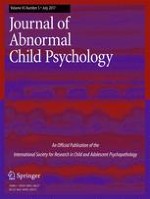28-10-2016
Factors Associated with Healthy and Impaired Social Functioning in Young Adolescents with ADHD
Gepubliceerd in: Research on Child and Adolescent Psychopathology | Uitgave 5/2017
Log in om toegang te krijgenAbstract
There is variability in the extent to which adolescents with attention-deficit/hyperactivity disorder (ADHD) exhibit social impairment, as the same diagnosis does not necessarily entail impairment in the same area(s) of functioning. The current study entailed a cross-sectional examination of enhancers to healthy social functioning and risk factors to parent- and self-rated social impairment in 324 middle school youth (ages 10–14 years) with ADHD. A series of binary logistic regression analyses were conducted to evaluate a risk-resilience model for social functioning, including testing compensatory (i.e., main; buffering) and protective (i.e., interaction) effects of enhancers in the presence of identified risk factors. Youth conduct problems, youth depression, and negative parenting emerged as risk factors. Self-rated social acceptance, activity participation (breadth and intensity), and parent involvement were enhancers of healthy social functioning. Of these enhancers, activity participation (breadth and intensity) and parent involvement showed buffering effects against the negative impact of the risk factors on social functioning. None of the enhancers displayed protective effects. The findings of this study enhance our understanding of the social functioning of young adolescents with ADHD, who comprise an understudied population relative to younger children with similar problems.
